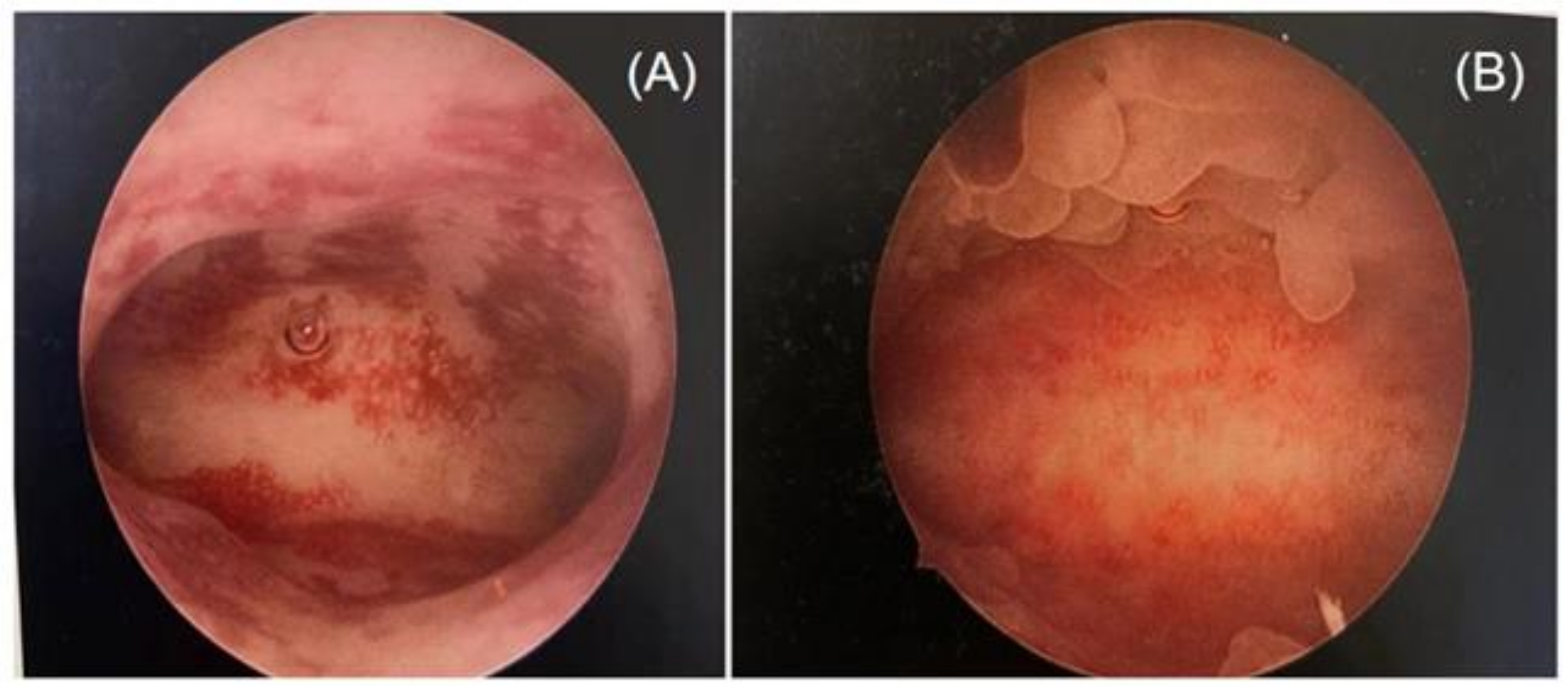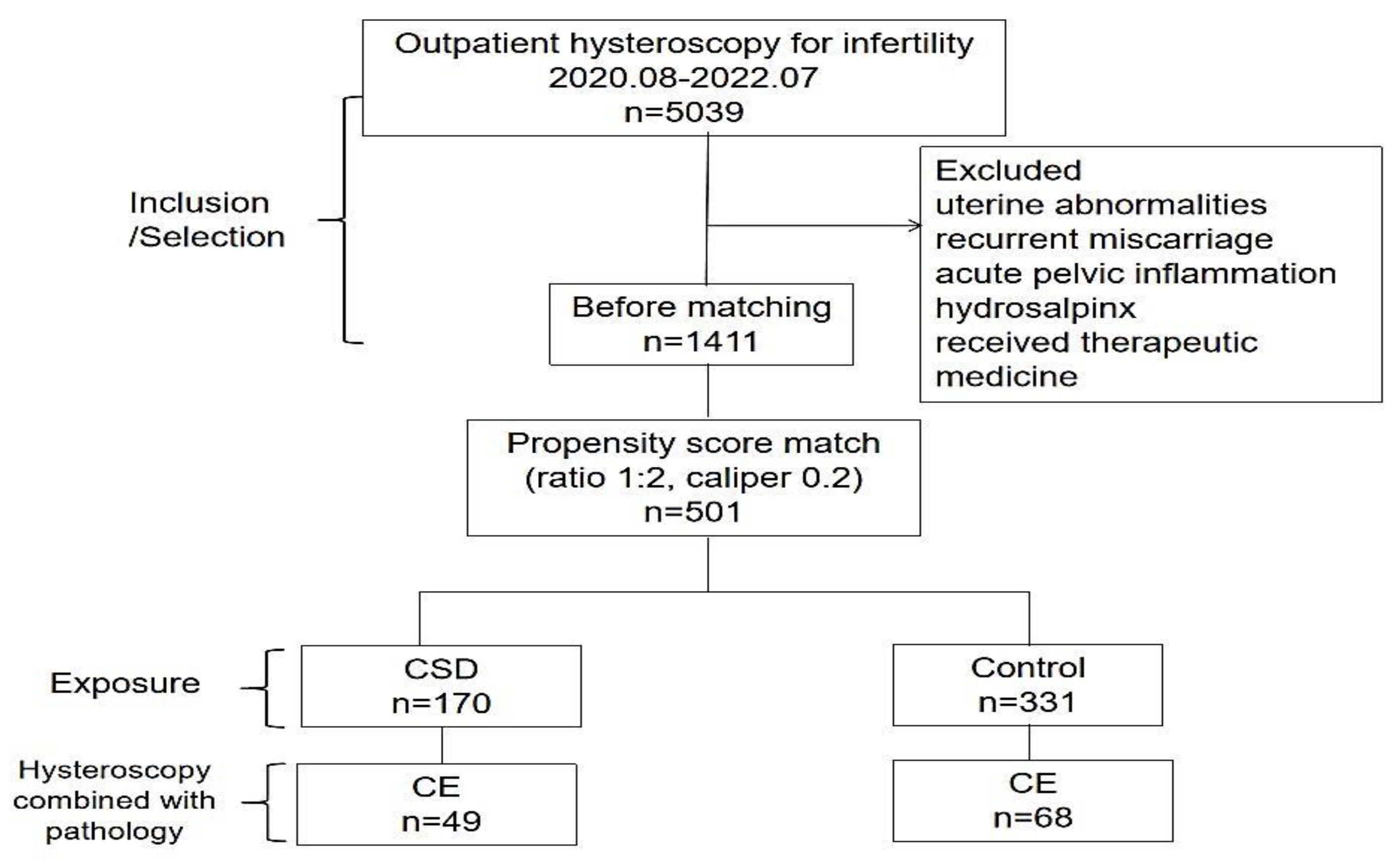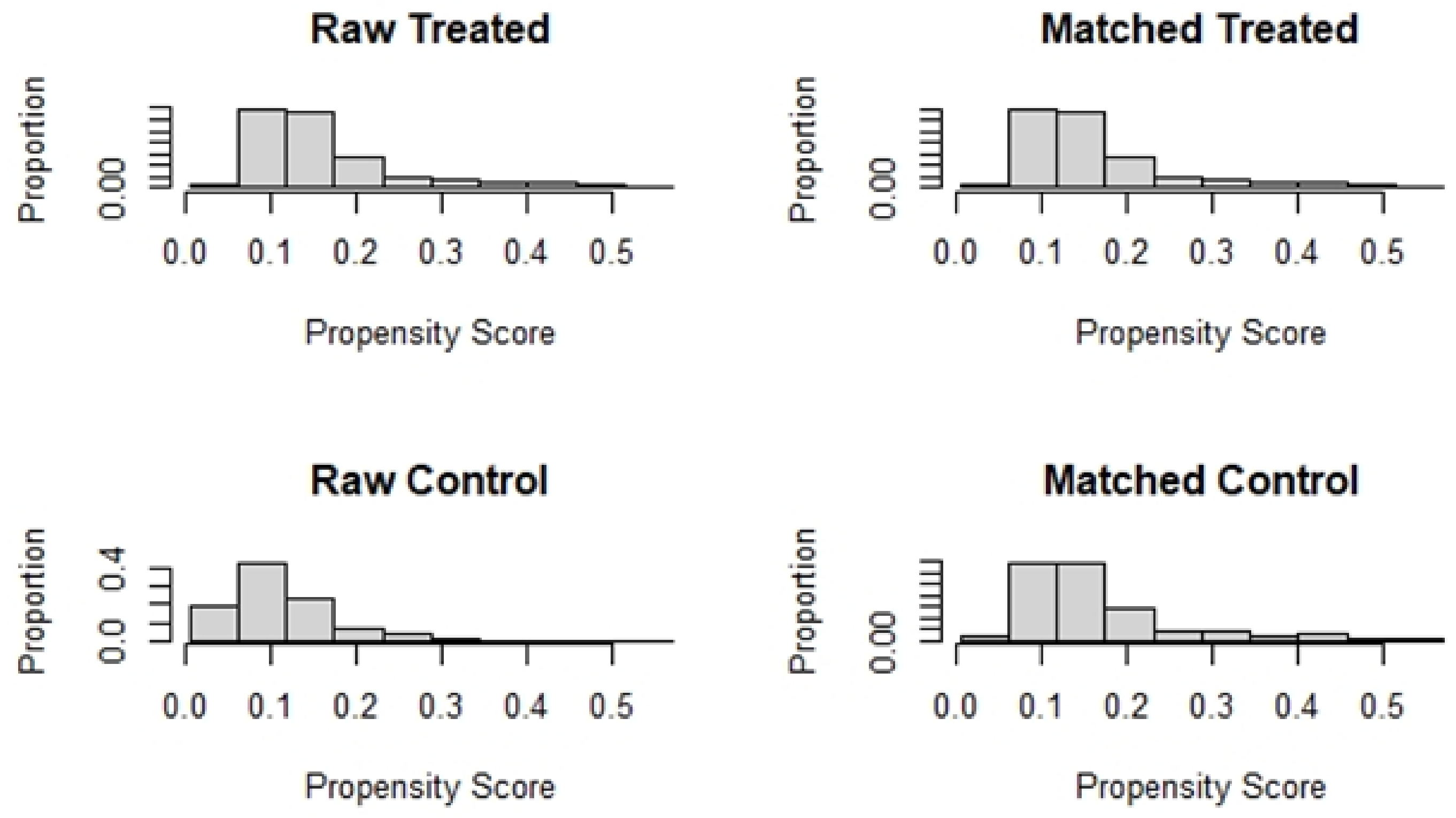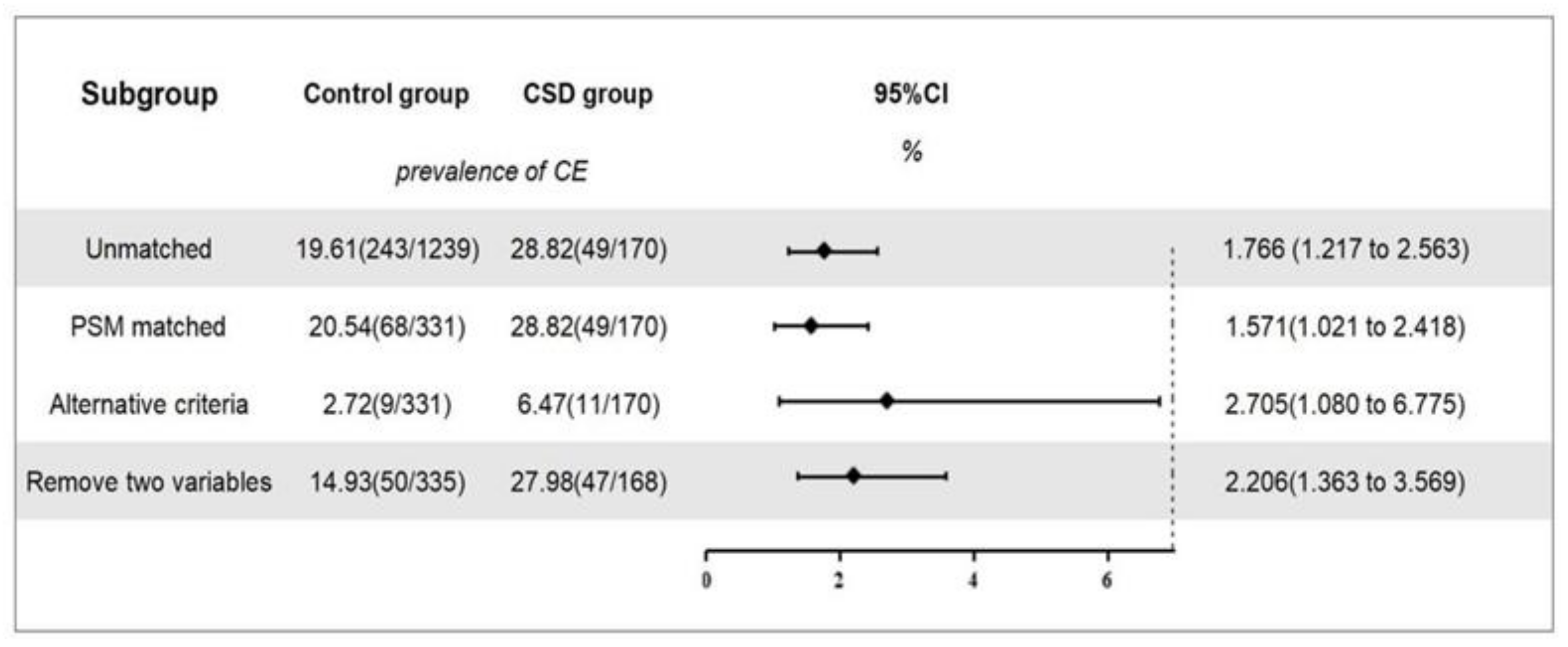Higher Prevalence of Chronic Endometritis in Women with Cesarean Scar Defect: A Retrospective Study Using Propensity Score Matching
Abstract
1. Introduction
2. Methods and Materials
2.1. Recruitment of Patients
2.2. Definitions
2.3. Diagnosis of CE
2.3.1. Hysteroscopy and Sample Collection
2.3.2. Histological and Immunochemistry Analysis
2.4. Propensity Score Matching (PSM)
2.5. Statistics
3. Results
3.1. Baseline Characteristics before and after Propensity Score Matching
3.2. Outcomes before and after Matching
4. Discussion
5. Conclusions
Author Contributions
Funding
Institutional Review Board Statement
Informed Consent Statement
Data Availability Statement
Conflicts of Interest
References
- Donnez, O.; Donnez, J.; Orellana, R.; Dolmans, M.-M. Gynecological and obstetrical outcomes after laparoscopic repair of a cesarean scar defect in a series of 38 women. Fertil. Steril. 2016, 107, 289–296.e2. [Google Scholar] [CrossRef] [PubMed]
- Osser, O.V.; Jokubkiene, L.; Valentin, L. High prevalence of defects in Cesarean section scars at transvaginal ultrasound examination. Ultrasound Obstet. Gynecol. 2009, 34, 90–97. [Google Scholar] [CrossRef]
- Florio, P.; Filippeschi, M.; Moncini, I.; Marra, E.; Franchini, M.; Gubbini, G. Hysteroscopic treatment of the cesarean-induced isthmocele in restoring infertility. Curr. Opin. Obstet. Gynecol. 2012, 24, 180–186. [Google Scholar] [CrossRef] [PubMed]
- Luo, L.; Niu, G.; Wang, Q.; Xie, H.-Z.; Yao, S.-Z. Vaginal Repair of Cesarean Section Scar Diverticula. J. Minim. Invasive Gynecol. 2012, 19, 454–458. [Google Scholar] [CrossRef] [PubMed]
- Schepker, N.; Garcia-Rocha, G.-J.; von Versen-Höynck, F.; Hillemanns, P.; Schippert, C. Clinical diagnosis and therapy of uterine scar defects after caesarean section in non-pregnant women. Arch. Gynecol. Obstet. 2014, 291, 1417–1423. [Google Scholar] [CrossRef]
- Gubbini, G.; Centini, G.; Nascetti, D.; Marra, E.; Moncini, I.; Bruni, L.; Petraglia, F.; Florio, P. Surgical Hysteroscopic Treatment of Cesarean-Induced Isthmocele in Restoring Fertility: Prospective Study. J. Minim. Invasive Gynecol. 2011, 18, 234–237. [Google Scholar] [CrossRef]
- Tulandi, T.; Cohen, A. Emerging Manifestations of Cesarean Scar Defect in Reproductive-aged Women. J. Minim. Invasive Gynecol. 2016, 23, 893–902. [Google Scholar] [CrossRef]
- Tower, A.M.; Frishman, G.N. Cesarean Scar Defects: An Underrecognized Cause of Abnormal Uterine Bleeding and Other Gynecologic Complications. J. Minim. Invasive Gynecol. 2013, 20, 562–572. [Google Scholar] [CrossRef]
- Liu, S.; Shi, L.; Shi, J. Impact of endometrial cavity fluid on assisted reproductive technology outcomes. Int. J. Gynecol. Obstet. 2015, 132, 278–283. [Google Scholar] [CrossRef]
- Michels, T.C. Chronic endometritis. Am. Fam Physician. 1995, 52, 217–222. [Google Scholar]
- Yang, X.; Pan, X.; Cai, M.; Zhang, B.; Liang, X.; Liu, G. Microbial Flora Changes in Cesarean Section Uterus and Its Possible Correlation With Inflammation. Front. Med. 2021, 8, 651938. [Google Scholar] [CrossRef] [PubMed]
- Wiesenfeld, H.C.; Hillier, S.L.; Meyn, L.A.; Amortegui, A.J.; Sweet, R.L. Subclinical Pelvic Inflammatory Disease and Infertility. Obstet. Gynecol. 2012, 120, 37–43. [Google Scholar] [CrossRef]
- Romero, R.; Dey, S.K.; Fisher, S.J. Preterm labor: One syndrome, many causes. Science 2014, 345, 760–765. [Google Scholar] [CrossRef] [PubMed]
- Boyle, A.K.; Rinaldi, S.F.; Norman, J.E.; Stock, S.J. Preterm birth: Inflammation, fetal injury and treatment strategies. J. Reprod. Immunol. 2016, 119, 62–66. [Google Scholar] [CrossRef] [PubMed]
- Di Wu, D.; Kimura, F.; Zheng, L.; Ishida, M.; Niwa, Y.; Hirata, K.; Takebayashi, A.; Takashima, A.; Takahashi, K.; Kushima, R.; et al. Chronic endometritis modifies decidualization in human endometrial stromal cells. Reprod. Biol. Endocrinol. 2017, 15, 1–10. [Google Scholar] [CrossRef]
- Morris, H. Surgical pathology of the lower uterine segment caesarean section scar: Is the scar a source of clinical symptoms? Int. J. Gynecol. Pathol. 1995, 14, 16–20. [Google Scholar] [CrossRef]
- Higuchi, A.; Tsuji, S.; Nobuta, Y.; Nakamura, A.; Katsura, D.; Amano, T.; Kimura, F.; Tanimura, S.; Murakami, T. Histopathological evaluation of cesarean scar defect in women with cesarean scar syndrome. Reprod. Med. Biol. 2021, 21, e12431. [Google Scholar] [CrossRef]
- Austin, P.C. A critical appraisal of propensity-score matching in the medical literature between 1996 and 2003. Stat. Med. 2007, 27, 2037–2049. [Google Scholar] [CrossRef]
- Kamath, M.S.; Bosteels, J.; D’Hooghe, T.M.; Seshadri, S.; Weyers, S.; Mol, B.W.J.; Broekmans, F.J.; Sunkara, S.K. Screening hysteroscopy in subfertile women and women undergoing assisted reproduction. Cochrane Database Syst. Rev. 2019, 2019, CD012856. [Google Scholar] [CrossRef]
- Sardo, A.D.S.; Di Carlo, C.; Minozzi, S.; Spinelli, M.; Pistotti, V.; Alviggi, C.; De Placido, G.; Nappi, C.; Bifulco, G. Efficacy of hysteroscopy in improving reproductive outcomes of infertile couples: A systematic review and meta-analysis. Hum. Reprod. Update 2016, 22, 479–496. [Google Scholar] [CrossRef]
- Smit, J.G.; Kasius, J.C.; Eijkemans, M.J.C.; Koks, C.A.M.; van Golde, R.; Nap, A.W.; Scheffer, G.J.; Manger, P.A.P.; Hoek, A.; Schoot, B.C.; et al. Hysteroscopy before in-vitro fertilisation (inSIGHT): A multicentre, randomised controlled trial. Lancet 2016, 387, 2622–2629, Erratum in Lancet 2019, 393, 2394. [Google Scholar] [CrossRef]
- El-Toukhy, T.; Campo, R.; Khalaf, Y.; Tabanelli, C.; Gianaroli, L.; Gordts, S.S.; Gordts, S.; Mestdagh, G.; Mardesic, T.; Voboril, J.; et al. Hysteroscopy in recurrent in-vitro fertilisation failure (TROPHY): A multicentre, randomised controlled trial. Lancet 2016, 387, 2614–2621. [Google Scholar] [CrossRef]
- Elsetohy, K.A.A.A.; Askalany, A.H.; Hassan, M.; Dawood, Z. Routine office hysteroscopy prior to ICSI vs. ICSI alone in patients with normal transvaginal ultrasound: A randomized controlled trial. Arch. Gynecol. Obstet. 2014, 291, 193–199. [Google Scholar] [CrossRef]
- Bouet, P.-E.; El Hachem, H.; Monceau, E.; Gariépy, G.; Kadoch, I.-J.; Sylvestre, C. Chronic endometritis in women with recurrent pregnancy loss and recurrent implantation failure: Prevalence and role of office hysteroscopy and immunohistochemistry in diagnosis. Fertil. Steril. 2016, 105, 106–110. [Google Scholar] [CrossRef]
- Gkrozou, F.; Tsonis, O.; Dimitriou, E.; Paschopoulos, M. In women with chronic or subclinical endometritis is hysteroscopy suitable for setting the diagnosis? A systematic review. J. Obstet. Gynaecol. Res. 2020, 46, 1639–1650. [Google Scholar] [CrossRef]
- Fraser, I.S.; Critchley, H.O.; Broder, M.; Munro, M.G. The FIGO Recommendations on Terminologies and Definitions for Normal and Abnormal Uterine Bleeding. Semin. Reprod. Med. 2011, 29, 383–390. [Google Scholar] [CrossRef]
- Munro, M.G.; Critchley, H.O.; Fraser, I.S.; FIGO Menstrual Disorders Working Group. The FIGO classification of causes of abnormal uterine bleeding in the reproductive years. Fertil. Steril. 2011, 95, 2204–2208.e3. [Google Scholar] [CrossRef]
- Raimondo, G.; Grifone, G.; Raimondo, D.; Seracchioli, R.; Scambia, G.; Masciullo, V. Hysteroscopic Treatment of Symptomatic Cesarean-induced Isthmocele: A Prospective Study. J. Minim. Invasive Gynecol. 2015, 22, 297–301. [Google Scholar] [CrossRef]
- Fabres, C.; Aviles, G.; De La Jara, C.; Escalona, J.; Muñoz, J.F.; Mackenna, A.; Fernández, C.; Zegers-Hochschild, F.; Fernández, E. The Cesarean Delivery Scar Pouch: Clinical implications and diagnostic correlation between transvaginal sonography and hysteroscopy. J. Ultrasound Med. 2003, 22, 695–700, quiz 701–702. [Google Scholar] [CrossRef]
- Marotta, M.-L.; Donnez, J.; Squifflet, J.; Jadoul, P.; Darii, N.; Donnez, O. Laparoscopic Repair of Post-Cesarean Section Uterine Scar Defects Diagnosed in Nonpregnant Women. J. Minim. Invasive Gynecol. 2013, 20, 386–391. [Google Scholar] [CrossRef]
- Carson, S.A.; Kallen, A.N. Diagnosis and Management of Infertility: A Review. JAMA 2021, 326, 65–76. [Google Scholar] [CrossRef] [PubMed]
- Guerriero, S.; Ajossa, S.; Lai, M.; Mais, V.; Paoletti, A.; Melis, G. Transvaginal ultrasonography associated with colour Doppler energy in the diagnosis of hydrosalpinx. Hum. Reprod. 2000, 15, 1568–1572. [Google Scholar] [CrossRef] [PubMed][Green Version]
- Yu, D.; Wong, Y.-M.; Cheong, Y.; Xia, E.; Li, T.-C. Asherman syndrome—One century later. Fertil. Steril. 2008, 89, 759–779. [Google Scholar] [CrossRef] [PubMed]
- Salim, R.; Woelfer, B.; Backos, M.; Regan, L.; Jurkovic, D. Reproducibility of three-dimensional ultrasound diagnosis of congenital uterine anomalies. Ultrasound Obstet. Gynecol. 2003, 21, 578–582. [Google Scholar] [CrossRef] [PubMed]
- Bocca, S.M.; Abuhamad, A.Z. Use of 3-dimensional sonography to assess uterine anomalies. J. Ultrasound Med. 2013, 32, 1–6. [Google Scholar] [CrossRef]
- Amro, B.; Aristondo, M.E.R.; Alsuwaidi, S.; Almaamari, B.; Hakim, Z.; Tahlak, M.; Wattiez, A.; Koninckx, P.R. New Understanding of Diagnosis, Treatment and Prevention of Endometriosis. Int. J. Environ. Res. Public Health 2022, 19, 6725. [Google Scholar] [CrossRef]
- Kitaya, K.; Yasuo, T. Immunohistochemistrical and Clinicopathological Characterization of Chronic Endometritis. Am. J. Reprod. Immunol. 2011, 66, 410–415. [Google Scholar] [CrossRef]
- Song, D.; Feng, X.; Zhang, Q.; Xia, E.; Xiao, Y.; Xie, W.; Li, T.C. Prevalence and confounders of chronic endometritis in premenopausal women with abnormal bleeding or reproductive failure. Reprod. Biomed. Online 2018, 36, 78–83. [Google Scholar] [CrossRef]
- Kannar, V.; Lingaiah, H.K.M.; Sunita, V. Evaluation of Endometrium for Chronic Endometritis by Using Syndecan-1 in Abnormal Uterine Bleeding. J. Lab. Physicians 2012, 4, 69–73. [Google Scholar] [CrossRef]
- Huang, W.; Liu, B.; He, Y.; Xie, Y.; Liang, T.; Bi, Y.; Yuan, L.; Qin, A.; Wang, Y.; Yang, Y. Variation of diagnostic criteria in women with chronic endometritis and its effect on reproductive outcomes: A systematic review and meta-analysis. J. Reprod. Immunol. 2020, 140, 103146. [Google Scholar] [CrossRef]
- Chen, Y.-Q.; Fang, R.-L.; Luo, Y.-N.; Luo, C.-Q. Analysis of the diagnostic value of CD138 for chronic endometritis, the risk factors for the pathogenesis of chronic endometritis and the effect of chronic endometritis on pregnancy: A cohort study. BMC Women’s Health 2016, 16, 60. [Google Scholar] [CrossRef]
- Li, Y.; Xu, S.; Yu, S.; Huang, C.; Lin, S.; Chen, W.; Mo, M.; Lian, R.; Diao, L.; Ding, L.; et al. Diagnosis of chronic endometritis: How many CD138 + cells/HPF in endometrial stroma affect pregnancy outcome of infertile women? Am. J. Reprod. Immunol. 2020, 85. [Google Scholar] [CrossRef]
- Kasius, J.C.; Broekmans, F.J.M.; Sie-Go, D.M.D.S.; Bourgain, C.; Eijkemans, M.J.C.; Fauser, B.C.; Devroey, P.; Fatemi, H.M. The reliability of the histological diagnosis of endometritis in asymptomatic IVF cases: A multicenter observer study. Hum. Reprod. 2011, 27, 153–158. [Google Scholar] [CrossRef]
- Cicinelli, E.; Resta, L.; Loizzi, V.; Pinto, V.; Santarsiero, C.; Cicinelli, R.; Greco, P.; Vitagliano, A. Antibiotic therapy versus no treatment for chronic endometritis: A case-control study. Fertil. Steril. 2021, 115, 1541–1548. [Google Scholar] [CrossRef]
- Yang, R.; Du, X.; Wang, Y.; Song, X.; Yang, Y.; Qiao, J. The hysteroscopy and histological diagnosis and treatment value of chronic endometritis in recurrent implantation failure patients. Arch. Gynecol. Obstet. 2014, 289, 1363–1369. [Google Scholar] [CrossRef]
- Adegboyega, P.A.; Pei, Y.; McLarty, J. Relationship between eosinophils and chronic endometritis. Hum. Pathol. 2010, 41, 33–37. [Google Scholar] [CrossRef]
- Cicinelli, E.; Vitagliano, A.; Kumar, A.; Lasmar, R.B.; Bettocchi, S.; Haimovich, S.; International Working Group for Standardization of Chronic Endometritis Diagnosis. Unified diagnostic criteria for chronic endometritis at fluid hysteroscopy: Proposal and reliability evaluation through an international randomized-controlled observer study. Fertil. Steril. 2019, 112, 162–173.e2. [Google Scholar] [CrossRef]
- Kaku, S.; Kubo, T.; Kimura, F.; Nakamura, A.; Kitazawa, J.; Morimune, A.; Takahashi, A.; Takebayashi, A.; Takashima, A.; Kushima, R.; et al. Relationship of chronic endometritis with chronic deciduitis in cases of miscarriage. BMC Women’s Health 2020, 20, 1–6. [Google Scholar] [CrossRef]
- Morimune, A.; Kimura, F.; Nakamura, A.; Kitazawa, J.; Takashima, A.; Amano, T.; Kaku, S.; Moritani, S.; Kushima, R.; Murakami, T. The effects of chronic endometritis on the pregnancy outcomes. Am. J. Reprod. Immunol. 2020, 75, e13357. [Google Scholar] [CrossRef]
- Takebayashi, A.; Kimura, F.; Kishi, Y.; Ishida, M.; Takahashi, A.; Yamanaka, A.; Takahashi, K.; Suginami, H.; Murakami, T. The Association between Endometriosis and Chronic Endometritis. PLoS ONE 2014, 9, e88354. [Google Scholar] [CrossRef]
- Kimura, F.; Takebayashi, A.; Ishida, M.; Nakamura, A.; Kitazawa, J.; Morimune, A.; Hirata, K.; Takahashi, A.; Tsuji, S.; Takashima, A.; et al. Review: Chronic endometritis and its effect on reproduction. J. Obstet. Gynaecol. Res. 2019, 45, 951–960. [Google Scholar] [CrossRef] [PubMed]
- Gurol-Urganci, I.; Bou-Antoun, S.; Lim, C.; Cromwell, D.; Mahmood, T.; Templeton, A.; Van Der Meulen, J. Impact of Caesarean section on subsequent fertility: A systematic review and meta-analysis. Hum. Reprod. 2013, 28, 1943–1952. [Google Scholar] [CrossRef] [PubMed]
- Martingano, D.; Renson, A.; Rogoff, S.; Singh, S.; Nasir, M.K.; Kim, J.; Carey, J. Daily gentamicin using ideal body weight demonstrates lower risk of postpartum endometritis and increased chance of successful outcome compared with traditional 8-hour dosing for the treatment of intrapartum chorioamnionitis. J. Matern. Neonatal Med. 2018, 32, 3204–3208. [Google Scholar] [CrossRef] [PubMed]
- Smith, M.; Hagerty, K.A.; Skipper, B.; Bocklage, T. Chronic Endometritis: A Combined Histopathologic and Clinical Review of Cases From 2002 to 2007. Int. J. Gynecol. Pathol. 2010, 29, 44–50. [Google Scholar] [CrossRef]
- Johnston-MacAnanny, E.B.; Hartnett, J.; Engmann, L.L.; Nulsen, J.C.; Sanders, M.M.; Benadiva, C.A. Chronic endometritis is a frequent finding in women with recurrent implantation failure after in vitro fertilization. Fertil. Steril. 2010, 93, 437–441. [Google Scholar] [CrossRef]
- Vitagliano, A.; Saccardi, C.; Noventa, M.; Sardo, A.D.S.; Saccone, G.; Cicinelli, E.; Pizzi, S.; Andrisani, A.; Litta, P.S. Effects of chronic endometritis therapy on in vitro fertilization outcome in women with repeated implantation failure: A systematic review and meta-analysis. Fertil. Steril. 2018, 110, 103–112.e1. [Google Scholar] [CrossRef]




| Baseline | Control Group Prematch (n = 1239) | Control Group Postmatch (n = 331) | CSD Group (n = 170) | Standard Difference Prematch | Standard Difference Postmatch |
|---|---|---|---|---|---|
| Age (y, ± s) | 32.50 ± 3.52 | 34.98 ± 4.99 | 34.95 ± 4.31 | 0.5804 | −0.0529 |
| BMI (kg/m2, ± s) | 23.5 ± 3.52 | 23.73 ± 3.72 | 23.69 ± 3.61 | 0.0240 | −0.0177 |
| Gravidity (M, P25, P75) | 2.89 (1.0, 4.0) | 2.53 (1.0, 3.0) | 2.42 (1.0, 3.0) | −0.3421 | −0.0611 |
| Parity (M, P25, P75) | 1.27 (1.0, 2.0) | 1.13 (1.0, 1.0) | 1.16 (1.0, 1.0) | −0.2706 | 0.0881 |
| Infertility duration (y, ± s) | 3.73 ± 2.62 | 3.80 ± 2.79 | 3.79 ± 2.41 | 0.0228 | −0.0090 |
| History of IUD (n (%)) | |||||
| Yes | 22 (1.8) | 9 (2.7) | 5 (2.9) | 0.0673 | 0.0175 |
| No | 1217 (98.2) | 322 (97.3) | 165 (97.1) | 0.0498 | 0.0267 |
| History of prolonged menstruation (n (%)) | |||||
| Yes | 50 (4.0) | 20 (6.0) | 17 (10.0) | 0.2237 | 0.0844 |
| No | 1189 (96.0) | 311 (94.0) | 153 (90.0) | 0.3564 | 0.0767 |
Disclaimer/Publisher’s Note: The statements, opinions and data contained in all publications are solely those of the individual author(s) and contributor(s) and not of MDPI and/or the editor(s). MDPI and/or the editor(s) disclaim responsibility for any injury to people or property resulting from any ideas, methods, instructions or products referred to in the content. |
© 2022 by the authors. Licensee MDPI, Basel, Switzerland. This article is an open access article distributed under the terms and conditions of the Creative Commons Attribution (CC BY) license (https://creativecommons.org/licenses/by/4.0/).
Share and Cite
Wei, L.; Xu, C.; Zhao, Y.; Zhang, C. Higher Prevalence of Chronic Endometritis in Women with Cesarean Scar Defect: A Retrospective Study Using Propensity Score Matching. J. Pers. Med. 2023, 13, 39. https://doi.org/10.3390/jpm13010039
Wei L, Xu C, Zhao Y, Zhang C. Higher Prevalence of Chronic Endometritis in Women with Cesarean Scar Defect: A Retrospective Study Using Propensity Score Matching. Journal of Personalized Medicine. 2023; 13(1):39. https://doi.org/10.3390/jpm13010039
Chicago/Turabian StyleWei, Longlong, Chunyu Xu, Yan Zhao, and Cuilian Zhang. 2023. "Higher Prevalence of Chronic Endometritis in Women with Cesarean Scar Defect: A Retrospective Study Using Propensity Score Matching" Journal of Personalized Medicine 13, no. 1: 39. https://doi.org/10.3390/jpm13010039
APA StyleWei, L., Xu, C., Zhao, Y., & Zhang, C. (2023). Higher Prevalence of Chronic Endometritis in Women with Cesarean Scar Defect: A Retrospective Study Using Propensity Score Matching. Journal of Personalized Medicine, 13(1), 39. https://doi.org/10.3390/jpm13010039





